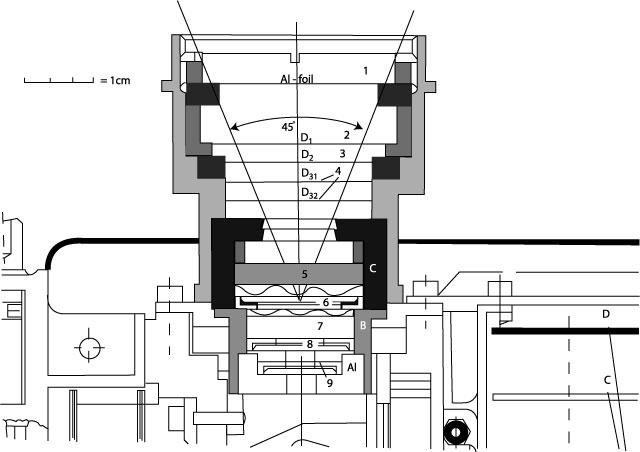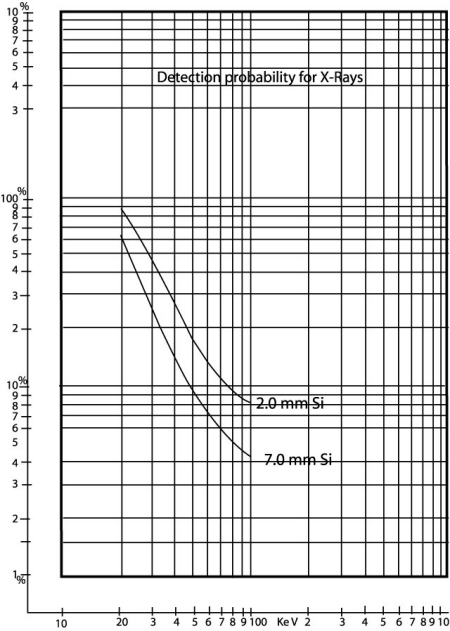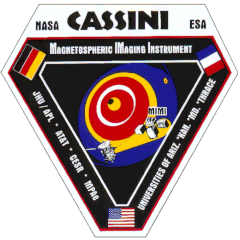CASSINI
Cassini MIMI Investigation at Fundamental Technologies
Historical MIMI Memos and Notes
(Note that the following text is purposely restated.)
LEMMS 180º End Design Criteria (as agreed by Engineering
Team Meeting)
(Tom Armstrong, 6/1/93)
- Optimize for clean coverage of proton spectrum from ~1 to >20 MeV.
- Obtain several electron channels, 1 - 10 MeV.
- Assume 100 ns time constants (pulse widths).
- Accept incidental x-ray responses to obtain (at least) upper limit fluxes.
- Specific, refined and optimized design parameters are needed ASAP.
- Weight and power constraints may dictate less complexity.
- Use ion implant detectors of least variety (in areas and thicknesses) possible (700 μ).
- Consider reducing D1 from 300 m to 100 m to reduce sensitivity to electrons.
- Consider reducing foil thickness from 100 m (A1 equivalent) to lower proton threshold to ~1 MeV.

Figure 2. Detection probability for x-rays

Summary of LEMMS Measurement Characteristics
| Detectors |
Energy range (MeV/nuc) |
Nuclear charge range |
Number of energy intervals measured |
Geometric factor (cm2 sr) |
Angular distribution (samples per rotation) |
Dynamic range (cm-2 sr-1 sec-1) |
| LEMMS A,B,C | 0.020-3.4 | z>=1 | 8 | 0.02 | 8, 16 | >=1-(10)8 |
| 3.4-10.5 | z=1 | 1 | 0.02 | 8 | 0.5-5(10)+ | |
| 0.85-3.1 (He) | z>=2 | 1 | 0.02 | 8 | >=1-5(10)7 | |
| 3.1-62.5 (He) | z=2 | 1 | 0.02 | 8 | 0.5-5(10)7 | |
| 1.5-10.5 | Electrons | 1 | 0.02 | 8 | 0.5-5(10)7 | |
| E1, E2 | 0.015-0.200 | Electrons | 4 | 0.03 | 8, 16 | <=1.5-5(10)7 |
| F1, F2 | 0.100-1.0 | Electrons | 4 | 0.015 | 8, 16 | <=5-106 |
| C,D | >2 | Electrons | 1 | 0.5 | 8 | <1-5(10)6 |
| >11 | Electrons | 1 | 0.5 | 8 | <1-5(10)6 | |
| 15.5-130 | z>=1 | 3 | 0.5 | 8 | <0.1-5(10)6 |
Figure 3. Saturnian x-ray spectra computed for observation distances of 10 RS and 50 RS.

Return to Historical MIMI Notes and Memos main page.
Return to Cassini
MIMI table of contents page.
Return to Fundamental
Technologies Home Page.
Updated 8/8/19, Cameron Crane
QUICK FACTS
Manufacturer: The Cassini spacecraft
was manufactured by NASA's Jet Propulsion Laboratory,
and the Huygens Probe was manufactured by Thales Alenia
Space.
Mission Duration: The Cassini-Huygens mission launched on October 15 1997, and ended on September 15 2017.
Destination: Cassini's destination was Saturn and its moons. The destination of the Huygens Probe's was Saturn's moon Titan.
Orbit: Cassini orbited Saturn for 13 years before diving between its rings and colliding with the planet on September 15th, 2017.
Mission Duration: The Cassini-Huygens mission launched on October 15 1997, and ended on September 15 2017.
Destination: Cassini's destination was Saturn and its moons. The destination of the Huygens Probe's was Saturn's moon Titan.
Orbit: Cassini orbited Saturn for 13 years before diving between its rings and colliding with the planet on September 15th, 2017.



